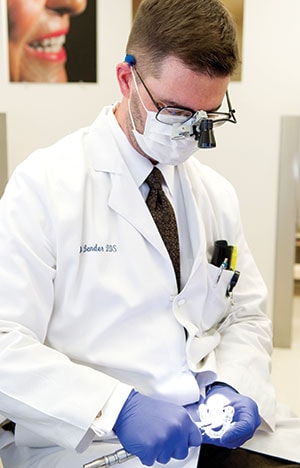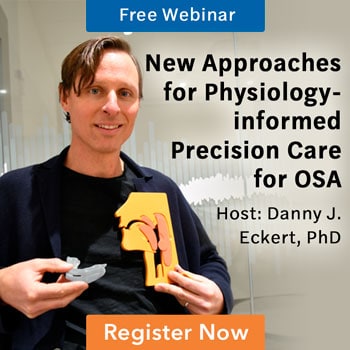Texas A&M University College of Dentistry has opened a new Facial Pain and Sleep Medicine center headed by Steven Bender, DDS. One of the first such centers in a dental school in the country, Dr. Bender has big ideas for how to change dentistry’s impact on whole person health. DSP recently sat down with Dr. Bender to learn more.
 DSP: Tell me how this all got started, Steve – this is a big project.
DSP: Tell me how this all got started, Steve – this is a big project.
Steven Bender, DDS: After I graduated from here in 1986, back when it was Baylor College of Dentistry, I started a general dentistry practice and stayed with it for about 13 years. One of my mentors, Dr. Henry Gremillion, then the director of the University of Florida’s Parker Mahan Center, allowed me to sort of intern with him for about two years. I would travel regularly to Gainesville to see patients in the clinic and learn from some of the best minds in pain therapy and research. Henry eventually told me I should ‘Pick one thing – Restorative or Pain, but knowing me the way that he did, he felt that it was best if I didn’t try to do both.’ So I sold the restorative portion of my practice and started treating only pain patients here in the Dallas area where I grew up.
For most of the 16 years since then, I was focused only on facial pain – I was aware of sleep problems, often treating insomnia and movement disorders with medications, but if there was an airway problem, I didn’t make the connection to my diagnosis and would send the airway issues to a colleague, Dr. Keith Thornton. Anyone who knows Keith also knows that he doesn’t leave you alone if he sees promise in creating another ‘sleep dentist’ so he made it clear that I needed to add treating the airway myself to my practice.
As many who read DSP magazine would guess, I started seeing much better results in my pain patients who had their airway issues treated, so that became a routine part of my therapy. What is important to know is that I think my pendulum swung a bit too far and I started seeing everyone with pain as an airway problem. Thankfully, my training from Dr. Gremillion stayed with me and I was able to improve my diagnosis so I could treat everyone appropriately.
As a teacher in this field, I get questions that make me feel that dentists aren’t always adequately trained in history-taking and can fall into the trap of seeing only airway issues (or, in the worst cases, only financial opportunities!) and not recognize other signs and symptoms as separate. All my teaching included a strong emphasis on diagnostic skills and hearing the patient’s story. I remember from years at Pankey and the Mahan Center that ‘knowing your patient’ includes much more than just the clinical signs and symptoms.
Over the course of a few years, the concept of creating a Center at Baylor began to take shape. Our Chair of Oral Surgery, Dr. David Grogan, has long been lobbying for a pain curriculum and we started talking, and Keith Thornton has been a big supporter as well. Along with the strong support of our Dean, Dr. Lawrence Wolinsky, we set up this new Center as a multi-disciplinary clinic. It opened in January this year – so far, we have limited space but hope to be able to expand soon. I was able to bring my assistant of 10 years with me, which was a huge blessing!
DSP: Please say more about what you want to do there. More than just moving your practice to another space, right?
SB: Dentists from all over will be able to come to our Center and see how we work up a patient history, make a treatment plan, and follow-through. I hope to replicate what Dr. Gremillion did for me and offer a preceptorship for committed dentists to gain in-depth understanding of how facial pain and sleep problems intertwine and are treated. We also plan to develop mini-residency type programs in pain and sleep to give the clinician in practice an educational opportunity beyond the normal weekend type venues. Also going forward, we plan to develop a CODA approved facial pain/sleep medicine residency program, which will offer certification as well as advanced degrees.
It is exciting to be able to offer dentists who want to put all the resources into a focused practice various educational avenues to fit their needs. What I’m very excited about that might have even more impact is that I get a chance to teach undergraduate dental students about pain and sleep in their third year. Also, we hope to be able to provide a hands on experience for the students in the diagnostic and treatment planning process for their pain and sleep disorder patients. I’ll certainly be looking for the special undergraduate student or two that shows interest and aptitude to mentor like others mentored me. Our goal is for every graduate from our institution to have at the least a basic understanding of sleep and pain issues. I think that is, at best, rare in most dental school graduates today. I’ve checked with some of the leaders of other programs around the country and we are all struggling to get time in the undergraduate student curriculum. Working with the grad students is a little easier, but still a challenge.
DSP: Lucky for the Dallas community. What else will the Center do?
SB: As someone long-committed to keeping up with the latest research and publications, I hope to be able to participate in projects here at the school that will add to the body of research involved in treating sleep and pain disorders, specifically with mandibular advancement devices, but also medically. With the resources of Texas A&M, we will be able to bring in our medical colleagues and create research projects that will help every clinician manage patients better. I’ve had some very exciting conversations with members of our clinical faculty, our basic scientists, faculty members of the medical school and some private practice sleep docs who all want to help create better-trained dentists.
We hope to produce a body of strong research to help the clinician in practice make the best choices for treating their pain and sleep patients. I believe that is where our center will make its mark. Keith and others here at the school have been instrumental in gaining support from independent foundations that will help us to begin the process of developing worthwhile projects. Obtaining research grants can be a difficult process and the National Institute of Dental and Craniofacial Research (NIDCR) likes to see some type of track record before allocating funds.
It’s well-known that most patients seek care in a medical or dental setting due to pain. One thing I want to emphasize to our students is that connecting with patients is very different in a pain/sleep clinic than in a typical dental office. I spend a lot of time getting the patient’s story, history, and making sure they felt cared-for. This came from my training with Dr. Gremillion – in many situations, I still find myself thinking “What would Henry do?” This is missing from most dental training these days. As dentists we are mostly taught to be therapists as opposed to good diagnosticians. We often get frustrated if we cannot “see” a problem to fix. Learning to connect with our patients is a powerful way to improve encounters between medical professionals and the people they serve. The better we can do with this, the happier patients we have. I think dentists trying to become well-regarded by the medical doctors in their communities should emphasize this in their practices. Focus on your patient’s story, create an exceptional experience for them, and they will tell the sleep docs about you. Here at the Center, we will always emphasize the person attached to these often-complicated pain and sleep problems.
DSP: I would think at a major institution that you also have access to the latest equipment, too.
SB: Sure, it’s nice to have a radiology department right across the hall, but dentists don’t need a lot of fancy equipment to treat pain and sleep patients well. As the new guy, I’m not asking for much yet, but I really don’t think that it’s about the gadget – it’s about what you know, what you can learn from the patient, and how you put those together to create the right treatment plan.
DSP: What else would you like the readers to know about your Center or treating patients in general? Do all dentists treating sleep need to study at a place like yours?
SB: Well, like I said, being successful at helping patients in pain or with sleep problems, or both, requires a thorough diagnosis. Involving the patient’s medical doctor is a must. We should also develop working relationships with other physicians and allied health care providers to ensure the best care for our patients. Currently, physicians are better trained in taking a proper history and performing a physical examination. We need to work with them to ensure that the patient is properly diagnosed and receives the most appropriate care.
Do dentists need to come to the Texas A&M Center for Facial Pain and Sleep Medicine? Well, certainly I hope that what we will offer will be a great place to learn. There are other programs of excellence around the country, but we do hope to add something unique. What dentists need to do above all is to see treating sleep disorders is not just about making an appliance and getting paid for it. It’s about creating a patient-doctor partnership. I’ve found that once the patient embraces this partnership, they can gain control of their conditions and that speeds the healing process. We need to develop a team approach to ensure our patients are well cared for for their lifetime.





